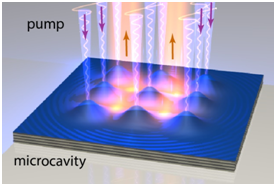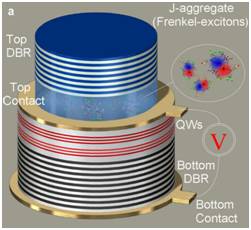QUANTUM OPTOELECTRONICS LABORATORYOF THE ICP
Team:
Group Leader:Prof. Pavlos Savvidis
Junhui Cao (PhD student)
Dr. Ioannis Paschos, John, Balas (PhD student)
ManolisMavrotsoupakis (PhD student)
Iliana Chalkoutsaki (Master Student)
Single polariton nonlinearities

Exciton polaritons are composite quasiparticles resulting from the strong coupling of cavity photons and quantum well (QW) excitons embedded within a microcavity (MC) [1]. Polaritons interact nonlinearly due to their excitonic component and can form macroscopically coherent condensates [2]. They are scalable to form arrays by either etching [3] or optical patterning [4] of the microcavity. However, in the presently studied systems, polariton-polariton interaction energy is smaller as compared to their line-broadening.
The goal of this project is to achieve nonlinear quantum regime in photonics where the single-site effective photon interaction energy is larger than the losses. This will open a plethora of interesting phenomena such as photon blockade, photon crystallisation and opportunities to realize quantum simulators for the study of condensed matter problems such as Mott-insulator to superfluid phase transitions in arrays of optical cavities. So far, the lack of scalable devices with sufficient nonlinearities and low-enough losses has been the main obstacle for the experimental realization of these phenomena. There are two approaches towards overcoming this problem: manufacturing higher quality microcavities or enhancing the polariton nonlinearities. Here, we employ electrically driven MC and exploit quantum confined Stark effect (QCSE) to form dipolar polaritons and tune exciton-exciton interaction[5]. Furthermore, we implement spatial lateral confinement in sub-μm pillars to squeeze and enhance further polariton-polariton interactions to achieve single polariton nonlinearities.
[1] C. Weisbuch,M.Nishioka, A. Ishikawa, and Y., Arakawa, Phys. Rev. Lett, 69, 3314 (1992).
[2] J. Kasprzak et al., Nature, 443, 409 (2006).
[3] T. Gao et al., , Phys. Rev. B 85, 235102 (2012).
[4] G. Tosi et al., Nat. Phys. 8, 190 (2012).
[5] S.I. Tsintzos et al., Phys. Rev. Lett. 121, 037401 (2018)
Spin lattices of polariton condensates for quantum sumulation
 Optical lattices have attracted much attention, since they can replicate quantum phase transition between the superfluid and Mott-insulating states of the Bose-Hubbard model. By experimentally modifying the lattice depth, one can control the relative strengths of the on-site interaction and inter-site hopping amplitude, Such systems have been of particular interest in the quantum information community since they realize a nearly ideal quantum simulator of the Hubbard model. The macroscopic nature of exciton-polariton condensates provides ease of optical access and probing of individual lattice sites. Furthermore, the non-equilibrium nature of exciton-polariton systems is particularly attractive, because it enables the preparation and study of non-equilibrium many-body phases in a naturally driven dissipative setting and permits in situ optical probing of these phases. The emerging field of polaritonics can be used for practical applications as the basis for quantum simulators.
Optical lattices have attracted much attention, since they can replicate quantum phase transition between the superfluid and Mott-insulating states of the Bose-Hubbard model. By experimentally modifying the lattice depth, one can control the relative strengths of the on-site interaction and inter-site hopping amplitude, Such systems have been of particular interest in the quantum information community since they realize a nearly ideal quantum simulator of the Hubbard model. The macroscopic nature of exciton-polariton condensates provides ease of optical access and probing of individual lattice sites. Furthermore, the non-equilibrium nature of exciton-polariton systems is particularly attractive, because it enables the preparation and study of non-equilibrium many-body phases in a naturally driven dissipative setting and permits in situ optical probing of these phases. The emerging field of polaritonics can be used for practical applications as the basis for quantum simulators.
Polariton simulators with weak on-site interactions and nonlinearities can be used to investigate a range of single-particle problems, such as Josephson oscillations of two coupled condensates, transport-related effects like Bloch oscillations, localization through controlled disorder and the effects of weak interactions, as well as more complex 2D phenomena pertaining to materials like graphene in the presence of external fields and aspects of quantum Hall physics. In order to realize quantum simulations of various interacting many-body systems, it will be important to attain stronger nonlinearities and tighter confining potentials, which we aim at in this project.
Our recent experiments have shown that individual polariton condensates can exhibit spontaneous magnetization, and that the spins of pairs of trapped polariton condensates can be controllably aligned . This constitutes a key step towards using trapped polariton condensates to realize interacting bosons of a driven-dissipative spinor Bose-Hubbard model. A lattice of polariton condensates can therefore model a non-equilibrium interacting spin system with unusual properties.
Our first main focus of this project is to use the flexibility of printing lattices of polariton condensates to implement quantum information processing tasks and to develop conceptually new analog quantum simulators (AQS). We aim to enhance on-site and nearest neighbour interactions by engineering polariton dipole moment and using tighter lateral photonic confinement. We also aim to study the spin properties of a closed interacting chain of exciton-polariton condensates as a controllable system to implement complex non-linear spin models out of equilibrium. Furthermore we aim to identify specific problems which can be simulated by the developed AQS.
[1] H. Ohadi et al., Physical Review B, 97, 195109 (2018)
[2] H. Ohadi et al., Physical Review Letters, 119, 067401 (2017)
[3] H. Ohadi et al., Physics Review Letters, 116, 106403 (2016)
[4] H. Ohadi et al.,Physical Review X, 5, 031002 (2015)
Hybrid Organic-Inorganic Microcavities
 Organic materials exhibit exceptional room temperature light emitting characteristics and enormous exciton oscillator strength, however, their low charge carrier mobility prevent their use in high-performance applications such as electrically pumped lasers. In this context, ultralow threshold polariton lasers, whose operation relies on Bose-Einstein condensation of polaritons – part-light part-matter quasiparticles, are highly advantageous since the requirement for high carrier injection no longer holds. Polariton lasers have been successfully implemented using inorganic materials owing to their excellent electrical properties, however, in most cases their relatively small exciton binding energies limit their operation temperature. It has been suggested that combining organic and inorganic semiconductors in a hybrid microcavity, exploiting resonant interactions between these materials would permit to dramatically enhance optical nonlinearities and operation temperature.
Organic materials exhibit exceptional room temperature light emitting characteristics and enormous exciton oscillator strength, however, their low charge carrier mobility prevent their use in high-performance applications such as electrically pumped lasers. In this context, ultralow threshold polariton lasers, whose operation relies on Bose-Einstein condensation of polaritons – part-light part-matter quasiparticles, are highly advantageous since the requirement for high carrier injection no longer holds. Polariton lasers have been successfully implemented using inorganic materials owing to their excellent electrical properties, however, in most cases their relatively small exciton binding energies limit their operation temperature. It has been suggested that combining organic and inorganic semiconductors in a hybrid microcavity, exploiting resonant interactions between these materials would permit to dramatically enhance optical nonlinearities and operation temperature.
In this project, we aim at creating cavity mediated hybridization inorganic semiconductor excitons such as GaAs and GaNwith organic or perovskite excitons in the strong coupling regime[1]. We aim at implementing electrical carrier injection via high mobility inorganic semiconductor to demonstrate low threshold, room temperature and broadly tunable polariton lasers. The new hybrid organic-inorganic microcavitydevices willutilize organic component for sustaining high temperature polariton condensation and efficient electrical injection through inorganic structure.
[1] G Paschos, et al., Scientific Reports 7, 11377 (2017)
[2] R. Jayaprakash et al., Light: Science & Appl. 8, 81 (2019)